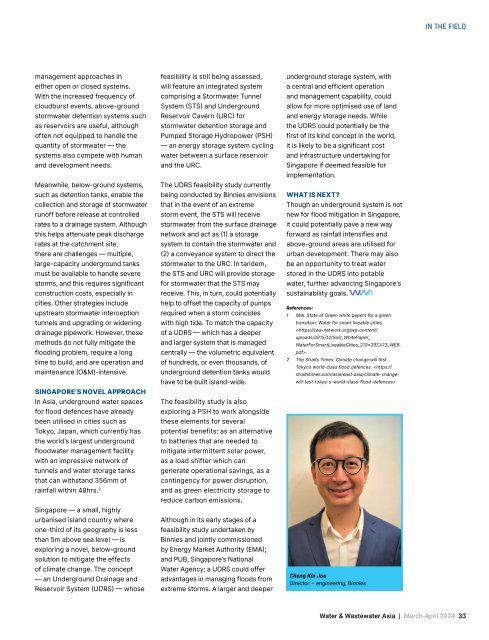Water & Wastewater Asia March/April 2024
Water & Wastewater Asia is an expert source of industry information, cementing its position as an indispensable tool for trade professionals in the water and wastewater industry. As the most reliable publication in the region, industry experts turn this premium journal for credible journalism and exclusive insight provided by fellow industry professionals. Water & Wastewater Asia incorporates the official newsletter of the Singapore Water Association (SWA).
Water & Wastewater Asia is an expert source of industry information, cementing its position as an indispensable tool for trade professionals in the water and wastewater industry. As the most reliable publication in the region, industry experts turn this premium journal for credible journalism and exclusive insight provided by fellow industry professionals. Water & Wastewater Asia incorporates the official newsletter of the Singapore Water Association (SWA).
You also want an ePaper? Increase the reach of your titles
YUMPU automatically turns print PDFs into web optimized ePapers that Google loves.
IN THE FIELD<br />
management approaches in<br />
either open or closed systems.<br />
With the increased frequency of<br />
cloudburst events, above-ground<br />
stormwater detention systems such<br />
as reservoirs are useful, although<br />
often not equipped to handle the<br />
quantity of stormwater — the<br />
systems also compete with human<br />
and development needs.<br />
Meanwhile, below-ground systems,<br />
such as detention tanks, enable the<br />
collection and storage of stormwater<br />
runoff before release at controlled<br />
rates to a drainage system. Although<br />
this helps attenuate peak discharge<br />
rates at the catchment site,<br />
there are challenges — multiple,<br />
large-capacity underground tanks<br />
must be available to handle severe<br />
storms, and this requires significant<br />
construction costs, especially in<br />
cities. Other strategies include<br />
upstream stormwater interception<br />
tunnels and upgrading or widening<br />
drainage pipework. However, these<br />
methods do not fully mitigate the<br />
flooding problem, require a long<br />
time to build, and are operation and<br />
maintenance (O&M)-intensive.<br />
SINGAPORE’S NOVEL APPROACH<br />
In <strong>Asia</strong>, underground water spaces<br />
for flood defences have already<br />
been utilised in cities such as<br />
Tokyo, Japan, which currently has<br />
the world’s largest underground<br />
floodwater management facility<br />
with an impressive network of<br />
tunnels and water storage tanks<br />
that can withstand 356mm of<br />
rainfall within 48hrs. 2<br />
Singapore — a small, highly<br />
urbanised island country where<br />
one-third of its geography is less<br />
than 5m above sea level — is<br />
exploring a novel, below-ground<br />
solution to mitigate the effects<br />
of climate change. The concept<br />
— an Underground Drainage and<br />
Reservoir System (UDRS) — whose<br />
feasibility is still being assessed,<br />
will feature an integrated system<br />
comprising a Stormwater Tunnel<br />
System (STS) and Underground<br />
Reservoir Cavern (URC) for<br />
stormwater detention storage and<br />
Pumped Storage Hydropower (PSH)<br />
— an energy storage system cycling<br />
water between a surface reservoir<br />
and the URC.<br />
The UDRS feasibility study currently<br />
being conducted by Binnies envisions<br />
that in the event of an extreme<br />
storm event, the STS will receive<br />
stormwater from the surface drainage<br />
network and act as (1) a storage<br />
system to contain the stormwater and<br />
(2) a conveyance system to direct the<br />
stormwater to the URC. In tandem,<br />
the STS and URC will provide storage<br />
for stormwater that the STS may<br />
receive. This, in turn, could potentially<br />
help to offset the capacity of pumps<br />
required when a storm coincides<br />
with high tide. To match the capacity<br />
of a UDRS — which has a deeper<br />
and larger system that is managed<br />
centrally — the volumetric equivalent<br />
of hundreds, or even thousands, of<br />
underground detention tanks would<br />
have to be built island-wide.<br />
The feasibility study is also<br />
exploring a PSH to work alongside<br />
these elements for several<br />
potential benefits: as an alternative<br />
to batteries that are needed to<br />
mitigate intermittent solar power,<br />
as a load shifter which can<br />
generate operational savings, as a<br />
contingency for power disruption,<br />
and as green electricity storage to<br />
reduce carbon emissions.<br />
Although in its early stages of a<br />
feasibility study undertaken by<br />
Binnies and jointly commissioned<br />
by Energy Market Authority (EMA);<br />
and PUB, Singapore’s National<br />
<strong>Water</strong> Agency; a UDRS could offer<br />
advantages in managing floods from<br />
extreme storms. A larger and deeper<br />
underground storage system, with<br />
a central and efficient operation<br />
and management capability, could<br />
allow for more optimised use of land<br />
and energy storage needs. While<br />
the UDRS could potentially be the<br />
first of its kind concept in the world,<br />
it is likely to be a significant cost<br />
and infrastructure undertaking for<br />
Singapore if deemed feasible for<br />
implementation.<br />
WHAT IS NEXT?<br />
Though an underground system is not<br />
new for flood mitigation in Singapore,<br />
it could potentially pave a new way<br />
forward as rainfall intensifies and<br />
above-ground areas are utilised for<br />
urban development. There may also<br />
be an opportunity to treat water<br />
stored in the UDRS into potable<br />
water, further advancing Singapore’s<br />
sustainability goals.<br />
References:<br />
1 IWA. State of Green white papers for a green<br />
transition: <strong>Water</strong> for smart liveable cities.<br />
<br />
2 The Straits Times. Climate change will test<br />
Tokyo’s world-class flood defences. <br />
Cheng Kin Joe<br />
Director – engineering, Binnies<br />
<strong>Water</strong> & <strong>Wastewater</strong> <strong>Asia</strong> | <strong>March</strong>-<strong>April</strong> <strong>2024</strong> 33

















